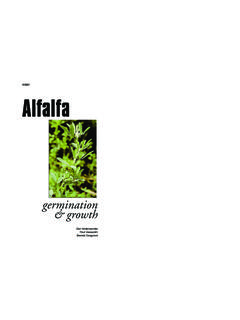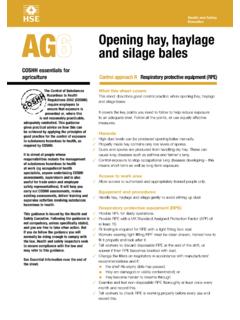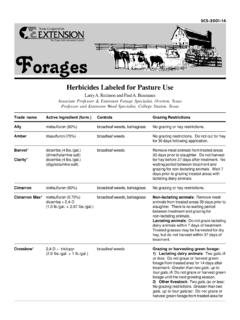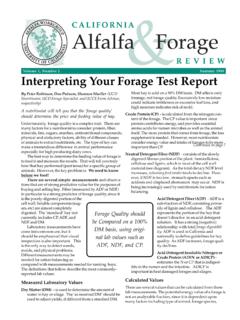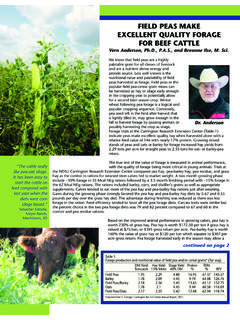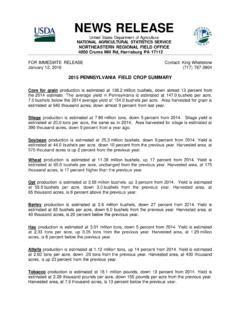Transcription of FORAGE Sorghum temp - Soil, Crop and More
1 FORAGE Sorghum Production Guide Dr. Twain Butler, Extension Agronomist Stephenville Dr. Brent Bean, Extension Agronomist - Amarillo Introduction The use of Sorghum has increased in recent years due to the fact that Sorghums require 1/3 to 1/2 less water than corn and is better adapted to most regions in Texas. In addition, quality of sorghums for FORAGE have improved. Sorghums used for FORAGE are typically grouped as a) FORAGE Sorghum , b) sudangrass, and c) Sorghum -sudan hybrids. Each of these types has different growth characteristics that influence how they should be used. Even within a type, considerable differences can exist between varieties. Typically, FORAGE sorghums are used for silage production or for a one cutting hay crop.
2 Sudangrass is most often used for grazing, multiple hay cuttings, or occasionally greenchop. Sorghum -sudan hybrids are best utilized for single or multiple hay cuttings and grazing. A new development in the last few years has been the introduction of photoperiod sensitive and brown mid-rib FORAGE sorghums and Sorghum -sudangrass hybrids. The introductions of these two traits may very well change how we utilize sorghums for FORAGE . Sorghum Descriptions FORAGE sorghums. FORAGE sorghums are often referred to by producers as Cane and have similar characteristics to grain Sorghum . Historically FORAGE sorghums have been associated with relatively small grain heads. However, more recently developed cultivars can produce grain yields similar to that of good grain Sorghum hybrids.
3 In irrigated trials grain yield of FORAGE Sorghum hybrids have ranged in yield from 1,100 lb to 10,000 lb per acre. FORAGE sorghums are typically taller, more leafy, and later maturing than grain Sorghum hybrids. Many of the FORAGE sorghums have a sweet stalk making them more palatable to livestock when utilized for grazing or for hay. The stalks of FORAGE Sorghum tend to be large and succulent, making them less palatable for grazing and sometimes slow in drying down for hay production. Their regrowth potential is not as good as the other types of sorghums making them more suitable for a one time hay cutting or for silage production. The FORAGE sorghums are capable of producing very high amounts of dry matter per acre. Sudangrasses.
4 Most sudangrass cutivars now sold are hybrids. Sudangrasses have smaller stems and more slender leaves than the FORAGE sorghums. They are used almost exclusively used for grazing, multiple hay cuttings or possibly greenchop. They have excellent regrowth potential, but total dry matter produced in any single cutting will likely be less than the other types of Sorghum . Sorghum -sudan hybrids. As the name suggests these hybrids are a cross between Sorghum and sudangrass. These are often called Haygrazers by producers and may or may not have a sweet stalk. They tend to take on characteristics intermediate between FORAGE sorghums and sudangrass. Grain heads produced will look more like sudangrass (a Johnsongrass looking head) than grain Sorghum .
5 Grain yield will be much lower and than that produced with FORAGE sorghums. Regrowth potential is intermediate. Sorghum -sudan hybrids in Texas are used for grazing, single or multiple hay cuttings, and greenchop. Although they are sometimes used for silage , Texas studies have shown yield and quality are generally less than that achieved with FORAGE sorghums. Brown midrib BMR Sorghums. Brown midrib- term used to describe forages ( Sorghum -sudan, FORAGE Sorghum , corn, and millets) that have lower % lignin and thus should have higher % digestibility (Table 1). The name refers to the brown coloration in the midrib of the plant, however, this brown coloration is just a tool to identify the cultivars that have this new genetics for lower lignin.
6 The degree of color has no meaning to relative degree of digestibility and is therefore meaningless. 25-50% less lignin increases digestibility as well as palatability. There is usually a trade-off with silage types having a high percentage of lodging when plant reaches soft dough stage due to the weaker stems associated with less lignin. Table 1. Quality of Conventional and Brown Midrib FORAGE Sorghum and Corn Component Conventional n=25 Brown Midrib n=20 Corn n=4 % CP range % ADF range % NDF range % Lignin range % IVTD range Source: Data from Bean et al. 2001. Table 2. Performance of Midlactation Cows on Brown Midrib Sorghum Sudan Grass Item Conventional Sorghum Brown Midrib Sorghum Conventional Corn Milk (kg/day) 20 b 26 a 26 a Fat (%) b a a Fat (kg/day) b a a Protein (%) b ab a Protein (kg/day) b a a Lactose (%) b a ab Lactose (kg/day) b a a Source: Data from Grant et al.
7 1995 There is significant variability in % lodging in both non and BMR Sorghum (Table 3). It is very important to select those varieties that have lower lodging potential , which will be a must for silage type sorghums. On average there is currently about a 10% yield drag with many of the commercial BMR sorghums, however, the increased quality will be advantageous when quality is needed ( silage for lactating dairy cows) (Table 2). There is also an increase cost associated with this new technology, therefore the type of livestock to be fed (nutrient requirement) should dictate which Sorghum is to be used. Table 3. Percent lodging and yield of selected conventional (C), Brown Midrib (BMR), photoperiod sensitive (PS) sorghums, and corn.
8 Variety Type % Lodging Yield Tons/A FS5 C 0 Canex II C 0 979 C 25 Silo N Feed C 60 2 Way SRS C 77 Canex 702 BMR 0 Millenium BMR 13 Garst 344 BMR 40 BMR 101 BMR 80 Maxi-Gain PS 0 MegaGreen PS 0 Corn C 0 Source: Data from Bean et al. 2001. Photoperiod Sensitive (PS) Sorghums. Flowering is initiated in plants in response to day length (actually the duration of night) or photoperiod. Plants have different requirements and are categorized by: long-day, short-day, or day neutral. The PS sorghums will not initiate flowering until the day length becomes less than approximately 12 h and 20 minutes. This means the plant will remain vegetative from mid-March to mid-September in central Texas. Even after the plant enters the reproductive stage (flowering initiated) it will take 3 to 4 weeks for the plants to actually head out.
9 In the Texas Panhandle region a fall freeze will generally kill the plant before heads will ever emerge from the whorl of the plant. These plants tend to be very tall if allowed to continue to grow. The advantage of the photoperiod sensitive trait is that since the plants remain in the vegetative state for a long period of time the plants will continue to add leaves and remain high in quality. By remaining in the vegetative stage longer, this allows for harvesting higher quality FORAGE and more flexibility as to when the FORAGE must be harvested. Typically, quality drops significantly once the Sorghum plant initiates flowering. Recent data suggest PS sorghums should be harvested on a 70-day interval to maximize yield, due to its regrowth potential.
10 However, if a one time cutting is desired, the PS trait greatly increases the window for when the FORAGE can be harvested without sacrificing quality. Antiquality Factors Prussic Acid Poisoning. Most Sorghums contain varying amounts of cyanogenic glucosides, which depend on the variety, growth stage, and environmental conditions. Cyanogenic glucosides can be hydrolyzed into hydrogen cyanide (HCN). Small plants, young shoots, tillers, and especially new regrowth are high in these glucosides. During any weather stress these tender shoots can poison livestock. If Sorghum is cut for hay and sun-dried the HCN is rapidly volatilized, and can be fed to livestock. If conditions are unfavorable and there is a question, plants can be analyzed at a certified lab if HCN > 500 ppm (DM basis) then the plants should not be grazed or fed.
